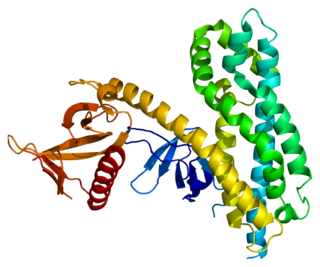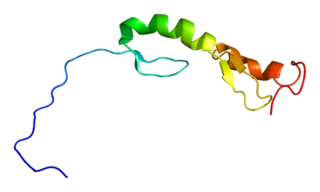
Trpc4-associated protein is a protein that in humans is encoded by the TRPC4AP gene.

Monocarboxylate transporter 8 (MCT8) is an active transporter protein that in humans is encoded by the SLC16A2 gene.

Sister chromatid cohesion protein PDS5 homolog B(PDS5B) is a protein that in humans is encoded by the PDS5B gene. It is a regulatory subunit of the Cohesin complex which mediates sister chromatid cohesion, homologous recombination and DNA looping. The core cohesin complex is formed of SMC3, SMC1, RAD21 and either SA1 or SA2. PDS5 associates with WAPL to stimulate the release of cohesin from DNA but during DNA replication PDS5 promotes acetylation of SMC3 by ESCO1 and ESCO2.

Rho guanine nucleotide exchange factor 4 is a protein that in humans is encoded by the ARHGEF4 gene.

Nuclear protein localization protein 4 homolog is a protein that in humans is encoded by the NPLOC4 gene.

TRAF-type zinc finger domain-containing protein 1 is a protein that in humans is encoded by the TRAFD1 gene.

SLX4 is a protein involved in DNA repair, where it has important roles in the final steps of homologous recombination. Mutations in the gene are associated with the disease Fanconi anemia.

HMG box transcription factor BBX also known as bobby sox homolog or HMG box-containing protein 2 is a protein that in humans is encoded by the BBX gene.

Putative sodium-coupled neutral amino acid transporter 10, also known as solute carrier family 38 member 10, is a protein that in humans is encoded by the SLC38A10 gene.

Protein FAM134C is a protein that in humans is encoded by the FAM134C gene.

The family with sequence similarity 73, member B, also known as FAM73B, is a human gene.

FUN14 domain containing 1 is a protein that in humans is encoded by the FUNDC1 gene.

Dynactin 5 (p25) is a protein that in humans is encoded by the DCTN5 gene.

CSRP2 binding protein is a protein that in humans is encoded by the CSRP2BP gene.

MDN1, midasin homolog (yeast) is a protein that in humans is encoded by the MDN1 gene. Midasin is a member AAA ATPase family.

Coiled-coil domain containing 137 is a protein that in humans is encoded by the CCDC137 gene.

Tubulin tyrosine ligase-like family, member 3 is a protein that in humans is encoded by the TTLL3 gene.

Solute carrier family 41, member 3 is a protein that in humans is encoded by the SLC41A3 gene.

Rho GTPase activating protein 25 is a protein that in humans is encoded by the ARHGAP25 gene. The gene is also known as KAIA0053. ARHGAP25 belongs to a family of Rho GTPase-modulating proteins that are implicated in actin remodeling, cell polarity, and cell migration.

Chromosome 2 open reading frame 54, otherwise known as Mab21L4, is a protein that in humans is encoded by the C2orf54 gene. The orthologue in mice is 2310007B03Rik.















